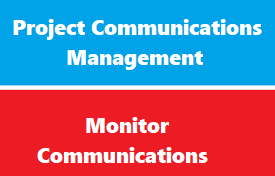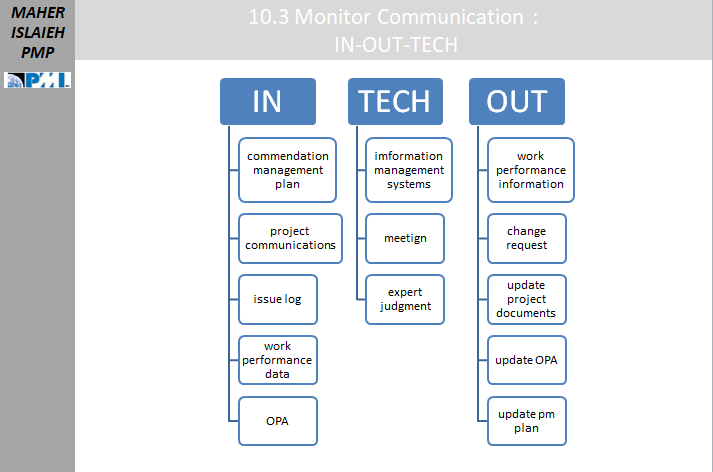introduction
This process entails making sure all stakeholders are receiving the right information at the right time.
The benefit from this process is that it ensures information needs of the stakeholders are being met at all time.
concepts
- Communication competence – information clarity, sharing, demonstrating leadership and relationship during communications
- Feedback – this includes mentoring or responses during the negotiation
- Nonverbal – body language and gestures, facial expressions and eye contact, voice characteristics, advanced techniques like mirroring
- Presentations – to a group of people
- By performing project reporting, the work performance report of the project is communicated to stakeholders in the customized manner they expect. Such tailored reports are known as project communications.
What should you monitor?
What should you monitor?
Monitoring should begin as soon as the project is being originated and it should occur in all the phases of the communication process.
During the research phase monitoring ensures that the identified community will be analyzed and prioritized appropriately.
During the planning phase monitoring provides indicators to closely check the feasibility and the way the project is supposed to progress.
During the implementation phase monitoring measures the effectiveness and the relevance of the activities being carried out.
It is important that the indicators for monitoring the process be established and agreed upon with the community.
This ensures the participatory nature of the program and avoids differences and misunderstandings in the expected outputs.
The following steps should assist you in planning and conducting the monitoring of the project activities:
- Establish the purpose of monitoring;
- Establish what will be monitored;
- Establish how it will be monitored (indicators);
- Establish when the monitoring will occur (checkpoints); and
- Establish who will be responsible for the monitoring.
Process inputs -techniques - outputs
Inputs
- commendation management plan
- project communications
- issue log
- work performance data
- OPA
Techniques
- information management systems
- meeting
- expert judgment
Outputs
- work performance information
- change request
- update project documents
- update OPA
- update pm plan
process inputs
Project Management Plan
it will be those components that have to do with communication.
- Resource management plan–recall that in the 6th Edition of the PMBOK® Guide the knowledge area of “resources” refers to both physical resources (equipment, materials, locations) and human resources (i.e., the project team members). In particular, the roles and responsibilities of the members of the project team may be necessary to review if the communications are sufficient.
- Communications management plan–this indicates the communications that are going out to team members and stakeholders.
- Stakeholder engagement plan–this identifies that the communication strategies that are planned to engage stakeholders based on their level of engagement in the project
Project Documents
Here are the project documents that may be used as inputs during this process.
- Issue logs–in particular, any issues related to stakeholder engagement will be relevant for this process.
- Lessons learned register–if lessons are learned with regards to stakeholder communications, then these will be added to the register to improve effectiveness of communication in the remainder of the project.
- Project communications–this provides information on the communications that have been distributed.
Work Performance Data
Remember, the process will take the actual work done–in the case of the communications knowledge area, it will be data on the types and quantities of communications that have actually been distributed–and compare it to what is specified in the Communications Management Plan.
Enterprise Environmental Factors
- Organizational culture and governance framework
- Established communication channels, tools and systems
Organizational Process Assets
- Corporate policies and procedures for social media (ethics and security issues)
- Standardized guidelines for exchange, storage and retrieval of information (legal requirements may require keeping of records for a certain period of time)
- Historical information and lessons learned from previous similar projects
process techniques
Expert Judgment
When making decisions about communications, the experts you may need to consult are those with expertise in
- communications, particularly in special environments like international or virtual environments.
- Project management systems and their communications requirements
Project Management Information System
- This is a set of standard software tools, like Microsoft Project, that can help capture, store, and disseminate information to team members, internal and external stakeholders. In the course of this process, the information contained in the PMIS system will be monitored for validity and effectiveness.
Data Representation
- The stakeholder engagement assessment matrix is an output of process Plan Stakeholder Engagement.
- It charts the current engagement level for each stakeholder and the desired (or planned) stakeholder engagement level, and is useful for monitoring the progress in moving between the current and desired level.
Interpersonal and Team Skills
There are two sources for information related to this process of monitoring and controlling communications.
- Dialogue and conversation with the project team to determine the most appropriate way to update and communicate project performance (the validity of the information).
- Responding to requests from stakeholders (the effectiveness of the information).
Meetings
- This can include both face-to-face and virtual meetings. Remember the ground rules of meetings that are discussed in my previous post:
process outputs
Monitor Communications: Outputs
Work Performance Information
- The whole point of this process is to compare how the communications on the project are actually performed (the Work Performance Data input to this process) and compare it with the results that were planned in the Communications Management Plan (another input to the process).
- This comparison is the Work Performance Information, which should be analyzed by the project team to get their feedback and that of stakeholders regarding the effectiveness of the communications.
- Any proposed changes should take be made as formal Change Requests (see next paragraphs).
Change Requests
- The change may be to communications to put them more in line with what’s in the Communications Management Plan, or it may be to the plan itself if the original plan turned out to be either unrealistic or if the stakeholders have changed their requirements with regards to those communications.
Project Management Plan Updates
the process may result in changes to the project management plan, in particular those components that have to do with communications:
- Communications Management Plan–any updated are included to the plan to make communications more effective
- Stakeholder engagement Plan–if the situation of stakeholders change and they want additional information about the project, these changes are reflected in the stakeholder engagement plan
Project Documents Updates
- Issue log–issues related to communication will be updated on this log
- Lessons learned register–if issues related to communication are resolved, the resolution and the corrective actions chosen will be updated in the lessons learned register so that communications can be made more effective for the rest of the project.
- Stakeholder register–if stakeholders have any changed requirements with regards to communications, these changes are updated in the stakeholder register.


